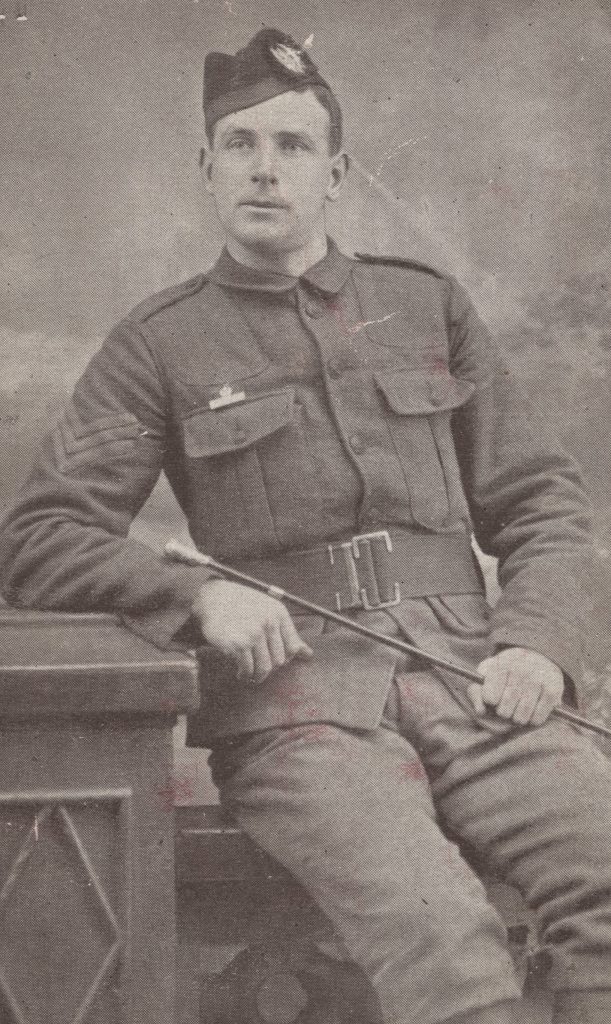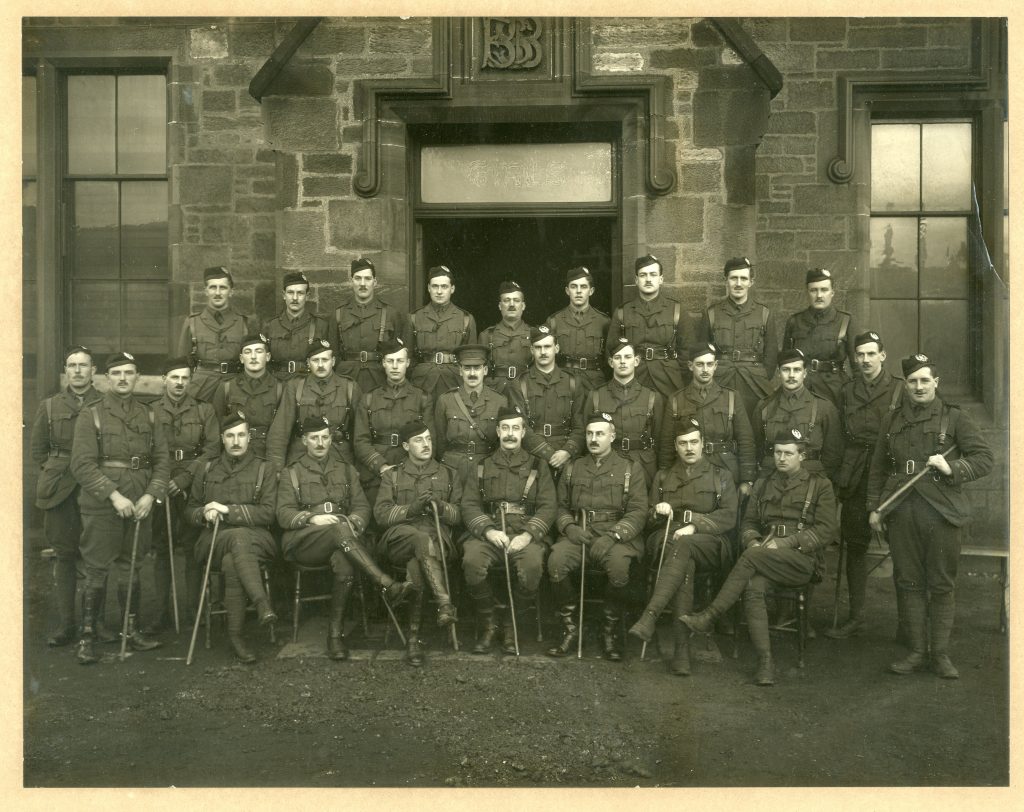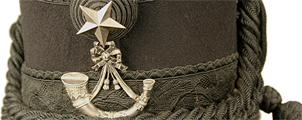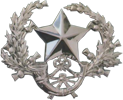Families and the Territorial Force
Tomorrow is the anniversary of the 7th and 8th Scottish Rifles’ attack on Gully Ravine on the Gallipoli peninsula. Based on cold statistics this was the worst single day The Cameronians (Scottish Rifles) suffered in the entirety of the First World War. While it would be many weeks for the scale of the losses to become known at home, we now know that between the two battalions over 470 men lost their lives in the attack. Not even in the opening phase of the Battle of Loos, in which many more battalions of the Regiment were engaged, would the casualties be matched. I don’t intend to go into the action at Gully Ravine in any great detail in this post; you can learn more about the 7th and 8th Battalions’ experience in that battle by reading my previous post marking the 100th anniversary. But this anniversary does provide an opportunity to remember the part played by the Territorial Force battalions of the Regiment as a whole, and the terrible losses felt by the communities these units represented.
The Territorial Force was created on 1 April 1908, the successor to the Volunteer Force of the mid-19th century. The men of the Territorial Force were ‘part time’ soldiers in that they remained in their civil employment but attended regular training weekends and drill nights where they were given a semblance of the training given to those soldiers of the Regular Army. Four battalions of the Territorial Force came under the parentage of The Cameronians (Scottish Rifles); the 5th, 6th, 7th and 8th Scottish Rifles. The 5th, 7th and 8th Battalions covered Glasgow, while the 6th Battalion belonged to Lanarkshire, and its headquarters were in Muirhall, Hamilton (now the site of Cameronian House – home of the Procurator Fiscal’s office and job centre). These battalions truly were microcosms of the areas they represented; the majority of men would live and work within the Battalion’s recruiting area, and many of the men would work together in the same businesses and industries. Many of the officers were drawn from the management and directorship levels of the companies and factories in which the men worked, while younger officers were often university students or graduates who had been attached to an Officer Training Corps. It was not uncommon for a private soldier or non commissioned officer of the Territorial Force to have their manager from their civilian occupation as a battalion officer.
One such example of this is Robert Downie of Hamilton; a draughtsman who was also a soldier of the 6th Scottish Rifles. In civilian life he worked in the offices of local architect Gavin Paterson, who also happened to be Lieutenant Colonel, commanding the 6th Scottish Rifles. Robert Downie did not survive the First World War. He went to France with the 6th Battalion in March 1915 as a sergeant and was awarded the Distinguished Conduct Medal for gallantry at Festubert, in June of that year. Downie was later commissioned and was also awarded the Military Cross for his actions when his battalion led the attack to push the German forces out of the French village of Clary, in late October 1918. Captain Robert Downie was killed on 6 November 1918, just five days before the Armistice.

Sergeant Robert Downie, 6th Scottish Rifles
The Battle of Festubert, in which Robert Downie earned his DCM, was the first major engagement in which the 6th Scottish Rifles took part. The Battalion suffered heavy losses, which were closely felt by the towns and villages of Lanarkshire from which the men of the battalion called home. By their nature, Territorial Force battalions were far likelier to contain men from the same families as might be found in the Regular battalions of the Army. Brothers, brothers-in-law, cousins, and even fathers and sons were found serving together in the Territorial Force battalions. Searching through casualty notices in the Motherwell Times yesterday, I came across this particularly heart breaking letter:
Letter from Private James Dickson – to his parents in Motherwell
“I regret very much to tell you that Jamie Baird died yesterday afternoon at 2.30. I got word yesterday morning that he was lying in a hospital barge in a canal about an hour’s walk from where we are billeted, so I got a pass immediately after parade, and set out to see him. I just got to the barge when a sergeant of the R.A.M.C. came down the gangway, so I asked if I could see Sergt. Baird, as he was a brother-in-law of mine, He had a slip of paper in his hand, and he showed me it with Jamie’s name on it, and said that if I had been ten minutes sooner I would have seen him pass away. He told me he died very peacefully, and I went on and saw him lying where he died. He was quite warm, and looked very nice. I asked what the nature of his wounds were. He told me he had one in the abdomen and one on the hand. I asked when he would be buried, so they sent me to another place further on and they told me there that he would be buried at six o’clock, so I hurried off to our billet and got a party of our company, and we laid him to rest in a nice little graveyard in a village which I can’t give you the name of just now, as we are not allowed to do so. Just break the news as gently as possible to poor Annie (Mrs Baird). I am heart sorry for her, and all my little nieces and nephews. They will miss their father, but he fell fighting and was brave to the last, although that is very little consolation to those who are left behind. I asked the ambulance sergeant major if he would put up a little cross and he promised to do so, and they told me that all the articles that were his would be sent to the base and then on to his wife.”
James Baird was married to Annie Dickson, Private James Dickson’s sister. James and Annie had seven children – the ‘little nieces and nephews’ mentioned in Private Dickson’s letter.

Sergeant James Baird, 6th Scottish Rifles
Two brothers from Motherwell, Robert and Isaac Devon, were also serving in the 6th Scottish Rifles during the Battle of Festubert. Isaac, who was soldier-servant to Captain Lusk, was wounded but survived, while Robert was wounded and died the following day.
Looking back to Gully Ravine, many families from Glasgow suffered multiple blows when the full extent of the losses among the 7th and 8th Battalions became known. A chilling newspaper article in the Daily Record of 27 July 1915 lists a number of casualties from the 8th Scottish Rifles. Printed at the head of the list is an appeal from one mother looking for information on her sons:
“Mrs. Annie Murdoch, 117 Alexandra Parade, has received intimation from Territorial Force Headquarters at Hamilton that her three sons – Gavin (21), Ronald (19), and William (17) – all in the 1/8th Cameronians, have been missing since 28th June. All three were in H Company.
Mrs. Murdoch has other two sons serving King and country – Norman (25) who is an electrical engineer in the Transport Department now in Flanders, and Hugh (15) in the Royal Navy, now on his way to the Dardanelles. Mrs. Murdoch will be glad to hear any tiding of her three missing sons.”
I could find no further mention of the Murdoch brothers in subsequent editions, however the Commonwealth War Graves Commission online register does record the names of a Gavin Murdoch, Ronald Murdoch, and William Murdoch, all having died on 28 June 1915 serving with the 8th Scottish Rifles. All three men are commemorated on the Helles Memorial, suggesting their remains were never identified. There are no obvious commemorative records for Hugh or Norman Murdoch, so one can hope that they at least returned safely to their mother in Glasgow at the Wars end.
This photograph shows the officers of the 8th Scottish Rifles, taken in late 1914.

Rear row, left to right: Lt E. Maclay*, 2Lt R. Humble, Lt J. T. Findlay*, Lt W. N. Sloan, Lt & QM H. Bowen*, 2Lt T. Stout*, 2Lt A. R. Tillie*, 2Lt W. S. Maclay*, Lt G. H. Crichton, Middle Row: 2Lt D. S. Carson, Capt C. J. C. Mowat*, 2Lt T. L. Tillie, Lt H. McCowan*, Captain W. C. Church*, Capt A. B. Sloan (RAMC), Capt H. A. MacLehose, Lt R. C. B. Macindoe*, Lt G. A. C. Moore*, Lt A. D. Templeton*, 2Lt J. W. Scott*, Capt E. T. Young*, Front row: Capt W. T. Law, Capt J. W. H. Pattison, Major R. N. Coulson, Major J. M. Findlay, Lt-Col H. M. Hannan*, Capt C. G. Bramwell*, Capt J. M. Boyd, Capt C. A. D. Macindoe* (* denotes died or killed in the War)
A few months after this photograph was taken, the Battalion would depart for Gallipoli. Of the 29 men shown in this photograph, 17 would never return home. Eleven of those were killed or died in the action at Gully Ravine on 28 June 1915. There are two pairs of brothers in this photograph; the Tillies and the Maclays, all young Second-Lieutenants. Two of the officers shown were also cousins; Lieutenant R. C. B. Macindoe and Captain C. A. D. Macindoe.
Talbot Lee Tillie was badly wounded on 28 June – his life was saved by one of his Sergeants, Stephen Miller, who risked his own life to drag the wounded officer back to the relative safety of the British lines. Arnold Reed Tillie did not survive the War. He had transferred to the Royal Flying Corps and was killed on 11 May 1916. A third Tillie brother, John Archibald, died on 19 July 1918, serving with the Black Watch.
William Strang Maclay died on 25 June 1915, in the lead up to the attack on Gully Ravine. His brother, Ebenezer, survived Gully Ravine, and a subsequent attack launched by the survivors of the 7th and 8th Scottish Rifles on 12 July 1915. Ebenezer was invalided home to the UK in August 1915, and subsequently transferred to the Scots Guards, with whom he was serving when he was killed on 11 April 1918.
Cecil and Ronald Macindoe, cousins, were both killed on 28 June at Gully Ravine.
Two of the officers pictured had also represented Scotland in Rugby; Captain W. C. Church, and Captain E. T. Young. Captain Church’s name is soon to be added to a new panel in the University of Glasgow Memorial Chapel, commemorating 19 men previously missing from the University’s roll of honour.
I can think of few other photographs that demonstrate the human cost of the War as clearly as this. The details listed above are, of course, just a few individual stories from the thousands that make up the Regiment’s losses in the First World War, but for me, they exemplify the particularly high price paid by all Territorial Force battalions of The Cameronians (Scottish Rifles).
Comments: 6



Some of its officers of the 7th Scottish Rifles had previously served in action abroad, and some had served together for several years. Indeed, its Commanding Officer Lieutenant-Colonel John Boyd Wilson, a stockbroker aged forty when the battalion was mobilised for war , had served in the Boer War near Greylingstad, and was at Vlakfontain when the battle of that name took place on 3rd July 1901. Likewise, his second-in-command Major Adam Templeton was thirty-nine, and had served for twenty-two years when the battalion left for Gallipoli. Both men had passed Examination C together in 1909, and Templeton had been a witness at Wilson’s wedding in 1905.
The Battalion’s Adjutant, Captain Robert Vere Clerk, was the son of a Lieutenant Colonel who had served in the Indian Army, and was a serving regular officer himself. However, unlike many attached to territorial battalions to perform the role, he was seconded from within the same regiment, 1st Battalion, and was thirty-one on mobilisation. Major William Bird, a merchant in civilian life, was thirty-three and, as mentioned previously, had undertaken the required courses as a Captain. Although his civilian role might not lend itself to military command style, he had extensive experience on his side.
At company level, the Captains were of a similar age, had established careers in civilian life, and had served for some years as territorial officers prior to the outbreak of war. For example, Captain Peter Whitton was thirty-seven and a civil engineer, Captain James Howatt was thirty-eight, and a measurer at the family business William Howatt and Sons of Buchanan Street, Glasgow. Captain Robert Johnstone was a thirty-six year old Draper and Jeweller, whereas in contrast, forty-nine-year-old Captain James Phillips had served as a Sergeant Major in the Battalion until successful in his application to become an officer, and the Quartermaster.
Lack of experience in the Territorial battalions (compared with regular officers) was more likely to be at junior officer level, where the age of those men leading platoons, alongside their limited experience of command, both as territorial officers, and in their civilian employment was likely to be a factor. Here, and using the example of B Company, Lieutenant Dan Taylor had been promoted shortly after mobilisation, and had served as a Second Lieutenant since early 1913 with no previous military experience. A manufacturers’ assistant in his father’s clothing factory, he was nineteen when the Battalion was mobilised. Second Lieutenant James Maclay was seventeen at mobilisation when he applied for a commission. Describing his occupation as ‘gentleman’, he had been in the Officer Training Corps at Rossall School.
Second Lieutenant Alister Duff (christened Alexander) was a wine merchant, again working for his father. Educated at Glasgow High School, Switzerland and Germany, he had been a private in the Highland Light Infantry Reserve Battalion whilst at school, and joined the 7th Scottish Rifles six months prior to sailing for Gallipoli as an officer aged twenty-seven. Finally, Lieutenant William Brown, a traveller of twenty-six on mobilisation, had been with the Battalion since November 1911, having previously served as a private in the 5th Scottish Rifles. All four were killed on 28th June 1915 at Gully Ravine alongside Colonel Wilson, Vere Clerk, and several others. So many died that day that the 7th and 8th Battalions had to form a composite battalion for the rest of the campaign under the command of Major Bird who was himself killed on 12th July, their next taste of the frontline.
Fantastic detail, Alastair. Thanks for sharing some of your research with us.
I haven’t looked outside the Regiment, but the adjutants of all four Scottish Rifles TF battalions that went to War in 1914/15 came from within The Cameronians (Scottish Rifles). Vere Clerk (7th Bn), and Bramwell (8th Bn) both died at Gallipoli. Croft (5th Bn) survived and finished the War in command of the 9th (Scottish) Division and having been awarded four DSOs. Draffen (6th Bn) survived but had been badly wounded and taken prisoner late in 1918 – he would retire shortly after the War’s end.
Thanks again for your comment.
Barrie this blog of yours is absolutely brilliant. It wea to see you both at Dougles on the 13th
Thank you for your kind words, Brian. It was lovely to see you at Douglas, and we look forward to catching up with you again at the earliest opportunity.
Thanks Barrie, of the eighty-five men killed, whose ages are known, from the one hundred and sixty-four men of the 7th Scottish Rifles who died on 28 June 1915, the oldest casualties were aged forty, the youngest seventeen. The most common age on death was nineteen. However, with no age recorded for seventy-five of that total, the true proportion of casualties aged twenty years and younger is probably higher judging by the photos.
Fascinating blog. My interest is based on the economic impact of WW1 on the wider Scottish economy post 1918 particularly with regard to the deaths in action of sons of the wealthiest Scots. 1/8 Cameronians being a unfortunate but prime example.